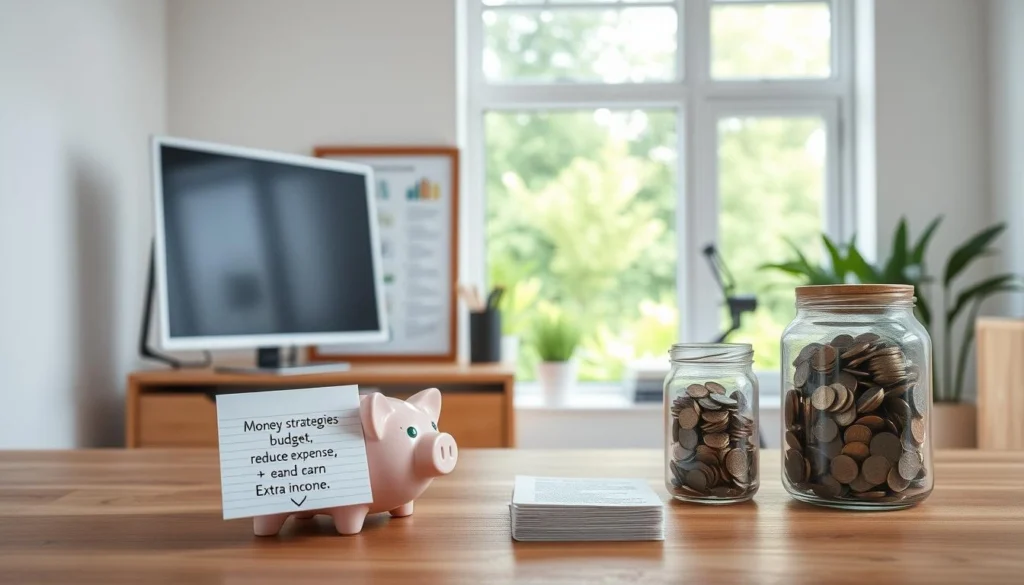Need to save $1000 fast but feel like you’re barely making ends meet? You’re not alone. Whether it’s an emergency or a big goal, sometimes you need to build savings quickly and it is possible.
With the right strategies, mindset, and small changes, you can start stacking cash faster than you think. Let’s break down practical, real-life ways to hit that $1000 goal without feeling overwhelmed.
Imagine having the financial security to cover unexpected expenses or achieve a long-held goal. This article will guide you through easy ways to save money, even on a limited budget.
The journey to saving $1000 may seem daunting, but with the right strategies, it’s achievable. We’ll explore practical tips to help you reach your financial goal.
Key Takeaways
- Understand the importance of saving $1000 quickly.
- Discover simple strategies to save money on a tight budget.
- Learn how to manage your finances effectively.
- Explore ways to reduce expenses and increase savings.
- Develop a plan to achieve your financial goal.
Why Saving $1000 Quickly Matters
Having $1000 in savings can be a game-changer in managing financial stress and unexpected expenses. It acts as a buffer that can help you navigate through life’s uncertainties without going into debt.
This amount is significant because it can cover many emergency situations, such as car repairs or medical bills, thereby reducing financial strain.
The Power of a $1000 Emergency Fund
An emergency fund of $1000 is more than just a savings goal; it’s a financial safety net. It provides the security to handle unexpected expenses, ensuring that you’re not forced to take on debt or dip into your long-term savings.
Having such a fund in place can also reduce stress and anxiety related to financial uncertainty.
Setting a Timeline for Your $1000 Goal
To achieve the goal of saving $1000, it’s crucial to set a realistic timeline. This involves assessing your current financial situation and determining how much you can save regularly.
By creating a targeted savings plan and sticking to it, you can reach your goal more efficiently. This plan should be based on your income, expenses, and other financial obligations.
Assess Your Current Financial Situation
To save $1000 fast, you need to have a clear picture of your financial landscape. This involves understanding your income, expenses, and savings potential.
Track Your Spending for One Week
Start by monitoring where your money goes for one week. This simple exercise can reveal surprising insights into your spending habits. Use a notebook, spreadsheet, or an app like Mint to log every purchase, no matter how small. This will help you identify areas where you can cut back.
Identify Your Income Sources
Make a list of all your income sources, including your salary, freelance work, investments, and any side hustles. Understanding how much money you have coming in is crucial for determining how much you can save.
Calculate Your Savings Potential
Once you have a clear picture of your income and expenses, calculate how much you can realistically save each week. Consider using the 50/30/20 rule as a guideline: 50% of your income for necessities, 30% for discretionary spending, and 20% for saving and debt repayment.

By assessing your financial situation, you can create a targeted savings plan that suits your needs. Effective budgeting for savings involves making conscious financial decisions that align with your goals.
Create a Targeted Savings Plan
When the goal is to save $1000 fast, having a targeted savings plan is essential.
This plan acts as a guide, helping you stay on track and achieve your financial goal within the desired timeframe.
Break Down Your $1000 Goal into Weekly Targets
Breaking down your $1000 goal into smaller, weekly targets makes the task less daunting.
For example, to save $1000 in 3 months, you need to save approximately $83 per week.
Choose the Right Savings Account
Choosing the right savings account is crucial.
Look for an account with no fees, high-interest rates, and easy access to your money.
| Savings Account Feature | Traditional Savings | High-Yield Savings |
|---|---|---|
| Interest Rate | Low | High |
| Fees | May have fees | Typically no fees |
Cut Your Monthly Bills Immediately
One of the most effective financial savings strategies is to lower your monthly bills immediately. By reducing your recurring expenses, you can allocate more funds towards saving $1000 quickly.
To start, take a close look at your current financial commitments. Identify areas where you can negotiate better rates or cut back on unnecessary expenses.
Negotiate Lower Rates on Recurring Services
Many service providers, such as cable and internet companies, often have promotions or discounts available that aren’t publicly advertised. By calling your service providers and negotiating, you can secure lower rates on your recurring bills.
For instance, your cable company might offer a promotional rate if you threaten to switch to a competitor. Similarly, your insurance provider may offer discounts if you bundle multiple policies together.
Audit and Cancel Unused Subscriptions
Unused subscriptions can drain your wallet without providing any real value. Take the time to audit your subscriptions, including streaming services, gym memberships, and software subscriptions.
Cancel any that you don’t use regularly. You might be surprised at how much you can save by eliminating just one or two unused services.
Reduce Utility Costs with Simple Changes
Simple changes in your daily habits can lead to significant reductions in your utility bills. For example, switching to energy-efficient light bulbs and being mindful of your water usage can make a big difference.
Additionally, adjusting your thermostat by just a degree or two can result in noticeable savings on your heating and cooling bills.

By implementing these strategies, you can significantly lower your monthly bills and accelerate your savings. Remember, every dollar saved is a step closer to reaching your $1000 goal.
Slash Your Food Budget Without Sacrificing Quality
Slash your food budget without sacrificing the taste or nutritional value of your meals with these practical tips. Reducing food expenses requires a strategic approach to meal planning, grocery shopping, and food management.
Meal Planning Strategies That Save $100+ Monthly
Effective meal planning is the first step towards saving money on food. By planning your meals around what’s on sale at the grocery store and using ingredients you already have, you can significantly cut down on waste and expenses.
“Meal planning is a game-changer for saving money on food. It helps you avoid last-minute takeout and reduces food waste.”
To start, plan your meals for the week, considering your schedule and dietary needs. Create a shopping list based on your meal plan to avoid buying unnecessary items.
Smart Grocery Shopping Tactics
Smart grocery shopping is crucial for saving money. Here are some tactics:
- Buy in bulk: Purchasing items like rice, pasta, and canned goods in bulk can save you money in the long run.
- Shop sales: Check the weekly ads for your local grocery stores and plan your shopping trip around the items on sale.
- Use coupons: Combine coupons with sales to maximize your savings.
| Smart Grocery Shopping Tactics | Potential Savings |
|---|---|
| Buying in Bulk | Up to 20% off |
| Shopping Sales | 10-15% off |
| Using Coupons | 5-10% off |
Reducing Food Waste at Home
Reducing food waste is another easy way to save money. According to the USDA, the average American household throws away about 40% of the food they buy. To reduce waste, implement these strategies:
- Use up leftovers: Plan meals that use leftover ingredients to reduce waste.
- Freeze items: Freeze vegetables, meat, and bread before they go bad.
- Understand expiration dates: Know the difference between “Sell By,” “Use By,” and “Best By” dates to avoid throwing away food that’s still safe to eat.
By implementing these strategies, you can enjoydelicious mealswhile keeping your food budget in check.
Transform Your Transportation Costs
One of the most effective ways to boost your savings is by optimizing your transportation costs. This involves making a few strategic changes to your daily commute and vehicle management.
Fuel-Saving Driving Techniques
Implementing fuel-saving driving techniques can significantly reduce your transportation expenses. Techniques such as maintaining a consistent speed, avoiding hard braking, and removing extra weight from your vehicle can improve your fuel efficiency.
Alternatives to Car Commuting
Exploring alternatives to car commuting can also help you save money. Consider using public transportation, carpooling, or biking to work. These alternatives not only reduce fuel consumption but also lower vehicle wear and tear.
Optimizing Auto Insurance Costs
Optimizing your auto insurance costs is another crucial step. Compare insurance providers to find the best rates, and consider adjusting your policy details, such as deductible levels, to lower your premiums.
| Transportation Cost Area | Savings Strategy | Potential Savings |
|---|---|---|
| Fuel Consumption | Fuel-saving driving techniques | $50/month |
| Commuting | Alternatives to car commuting | $100/month |
| Auto Insurance | Optimizing insurance costs | $30/month |
How to Save $1000 Fast with Hidden Money in Your Home

Your home might be holding the key to saving $1000 fast, and it’s time to unlock it. Often, we overlook the potential that lies within our own homes. By implementing a few simple strategies, you can tap into these hidden resources and accelerate your savings.
Declutter and Sell Unused Items
One of the quickest ways to boost your savings is by decluttering your home and selling items you no longer need or use. This not only helps in reducing clutter but also puts some cash in your pocket. You can sell items through online marketplaces, garage sales, or consignment shops.
For instance, that old bike gathering dust in your garage could be sold for a decent amount. Similarly, gently used clothing, electronics, and furniture can be sold online or to second-hand stores. Here are some popular platforms to consider:
Rent Out Unused Space or Assets
If you have an extra room or a parking space that’s not being utilized, consider renting it out. Platforms like Airbnb allow you to rent out your home or a room to travelers. Similarly, you can rent out your parking space on platforms like JustPark or Spacer.
As Warren Buffett once said, “Price is what you pay. Value is what you get.” Renting out unused space can provide you with a steady stream of income without much additional effort.
“The key to making money is to buy when others are fearful and sell when others are greedy.” – Warren Buffett
| Unused Space | Potential Rental Income |
|---|---|
| Extra Room | $200-$500/month |
| Parking Space | $50-$100/month |
| Storage Space | $100-$300/month |
Energy-Saving Home Adjustments
Making your home more energy-efficient not only reduces your utility bills but also contributes to a more sustainable lifestyle. Simple adjustments like switching to LED bulbs, sealing drafts, and using energy-efficient appliances can make a significant difference.
For example, replacing traditional incandescent bulbs with LED bulbs can save you up to $100 per year on electricity bills. Here are some energy-saving tips:
- Use energy-efficient appliances
- Seal drafts around windows and doors
- Install programmable thermostats
- Use LED bulbs
By implementing these strategies, you can save money, reduce waste, and contribute to a more sustainable future. Saving $1000 fast is achievable when you know where to look and how to act.
Boost Your Income with Side Hustles
To save $1000 fast, consider leveraging side hustles to supplement your primary income. This approach not only accelerates your savings but also diversifies your financial streams, making you more resilient to economic fluctuations.
Quick-Start Gig Economy Options
The gig economy offers numerous opportunities to earn extra money quickly. Platforms like Uber, Lyft, and DoorDash allow you to monetize your vehicle and spare time. Similarly, TaskRabbit and Fiverr enable you to offer your skills and services on a freelance basis.
- Sign up for multiple gig economy platforms to maximize your earning potential.
- Be strategic about when you work to capitalize on peak demand times.
Leveraging Skills for Freelance Work
If you have a particular skill, such as writing, graphic design, or programming, freelance work can be a lucrative side hustle. Platforms like Upwork and Freelancer connect professionals with clients seeking specific services.
“Freelancing allows you to choose projects that align with your interests and skills, potentially leading to higher earnings and greater job satisfaction.”
Passive Income Opportunities
Creating passive income streams can provide long-term financial benefits with minimal ongoing effort. Consider investing in dividend-paying stocks or real estate investment trusts (REITs), or creating digital products like e-books or online courses.
| Passive Income Stream | Initial Effort | Ongoing Income Potential |
|---|---|---|
| Dividend-paying Stocks | High | Medium |
| Real Estate Investment Trusts (REITs) | Medium | High |
| Digital Products | High | High |
By incorporating these side hustles into your financial strategy, you can significantly boost your income and accelerate your savings towards the $1000 goal.
Use Technology to Accelerate Your Savings
Technology has revolutionized the way we manage our finances, offering numerous tools to save money efficiently. By leveraging the right digital solutions, you can streamline your savings process and reach your $1000 goal faster.
Money-Saving Apps and Browser Extensions
Several apps and browser extensions are designed to help you save money. Apps like Qapital and Digit automatically transfer small amounts from your checking account to your savings. Browser extensions like Honey help you find and apply coupon codes at checkout, reducing your spending.
Automated Savings Tools
Automated savings tools simplify the process of setting aside money. Many banks offer automated transfers from checking to savings accounts. You can also use apps that round up your purchases to the nearest dollar or set up recurring transfers.
Cashback and Rewards Optimization
Cashback programs and rewards credit cards can help you save money on your daily purchases. Use a cashback credit card for your regular expenses and pay off the balance in full to avoid interest charges.
| Tool | Description | Benefits |
|---|---|---|
| Qapital | Automates savings based on your spending habits | Easy to use, customizable savings goals |
| Honey | Finds and applies coupon codes at checkout | Reduces spending, easy integration with online shopping |
| Digit | Automatically transfers small amounts to savings | Low maintenance, helps build savings habit |
Implement the 30-Day Money Challenge
The 30-day money challenge is a simple yet effective strategy for reducing unnecessary expenses and boosting your savings. This challenge is designed to help you develop healthy financial habits and reach your savings goal of $1000.
To start, you will need to commit to a structured plan. The challenge is divided into four weeks, each with a specific focus.
Week 1: No-Spend Days
Begin by designating certain days as no-spend days. This means avoiding unnecessary purchases and reducing your daily expenses. You can start with one or two no-spend days a week and gradually increase the number as you become more comfortable.
Week 2: Cutting Discretionary Spending
In the second week, focus on cutting discretionary spending. Identify areas where you can cut back, such as dining out or subscription services you don’t use. Use the 50/30/20 rule as a guideline: 50% for necessities, 30% for discretionary spending, and 20% for saving and debt repayment.
Weeks 3-4: Maximizing Savings Momentum
During the final two weeks, concentrate on maximizing your savings. Use automated savings tools or cashback apps to boost your savings. You can also consider budgeting for savings by allocating a specific amount each month towards your goal.
By following the 30-day money challenge, you can make significant progress towards saving for a goal and develop a more disciplined approach to budgeting for savings. Stay committed, and you’ll be on your way to reaching your $1000 target.
Avoid Common Pitfalls When Saving Money
While saving money is crucial, it’s equally important to avoid common pitfalls that can derail your efforts. Saving $1,000 quickly is a challenging task, and being aware of potential obstacles can help you stay on track.
Balancing Aggressive Saving with Quality of Life
Being too aggressive with your savings plan can lead to burnout. It’s essential to strike a balance between saving and enjoying your life. Allocate a small portion of your budget to activities that bring you joy, ensuring you don’t feel deprived.
Preventing Savings Burnout
To prevent burnout, implement quick money-saving hacks that don’t drastically alter your lifestyle. For example, using cashback apps or reducing dining out can be effective without feeling too restrictive.
Dealing with Unexpected Expenses
Unexpected expenses are inevitable. To mitigate their impact, build an emergency fund within your $1000 savings goal. This fund will help you avoid dipping into your savings when unexpected expenses arise, keeping you on track with your goal.
By being aware of these common pitfalls and using the best saving techniques, you can maintain a steady savings momentum and achieve your $1000 goal.
Conclusion: Maintaining Your Savings Momentum Beyond $1,000
Reaching your $1000 savings goal is a significant achievement, but it’s just the beginning. To save $1000 fast, you’ve likely implemented various financial savings strategies that can continue to serve you well beyond this milestone.
Maintaining your savings momentum requires ongoing commitment and a clear plan. Consider continuing to apply the strategies that helped you reach your initial goal, such as cutting unnecessary expenses, leveraging side hustles, and utilizing money-saving apps.
As you progress, you may want to set new financial targets, such as building an emergency fund or saving for a specific expense. By doing so, you’ll continue to strengthen your financial resilience and move closer to long-term financial stability.
Stay focused on your financial goals, and you’ll be surprised at how quickly your savings can grow. With persistence and the right financial savings strategies, you can achieve lasting financial success.


2 thoughts on “How to Save $1000 Fast (Even on a Tight Budget)”
Comments are closed.